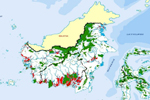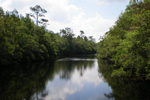Given that plantations cover 140 million hectares, or 4% of the global forested area, and are a growing source of round wood and pulp, Ecosystem Goods and Services from Plantation Forests is very well timed edited value that can add value to the discussion and implementation of sustainable forest management within a carbon constrained and biodiversity depleted global economic system.
The two main categories of plantation forests are productive plantations with 109.3 million ha planted globally and protective plantations with 30.1 million ha planted globally. In fact, in 2005 1/3rd of industrial round wood was sourced from productive plantations. The ten most common planted genera are Pinus, Cunninghamia, Eucalyptus, Populus, Acacia, Larix, Picea, Tectona, Castanea, and Quercus which together represent 2/3rds of the total species planted by ha. Therefore, a successful ecosystem goods and services strategy could initially focus on enhancement strategies pertaining to these ten specific genera.
Coupled with the global expansion of plantation forests along with, according to IUCN, the 1.6 billion people who rely upon forests for some aspect of their daily sustenance, it should be a critical imperative to frame out models such as total economic value (TEV) to measure, monitor, and improve upon ecosystem services that provide provisioning, regulating, supporting, and amenity values within the ecological environment of a plantation forest.
For example, a TEV analysis for a plantation forest would consider direct use value, indirect use value, option value, bequest value, and existence value. Each indicator would be overlaid, measured and analyzed separately against the provisioning, regulating, supporting and amenity values within the plantation forest.
Yet clearly ecosystem services enhancements can be site dependent. For example, hydrological impacts from large-scale forest plantations are broadly site specific with situations that demonstrate positive hydrological impacts from plantation forests and situations that present negative impacts from plantation forests. Catchment level impacts regarding surface run-off, groundwater recharge and stream flow are also site dependent.
Also, it has been demonstrated that in the context of plantation forests both ecosystem productivity increases with the level of biodiversity and improved biodiversity may stabilize ecosystem services. Furthermore, there are specific silvicultural activities that forest managers can engage in to enhance biodiversity values while creating a positive feedback loop as demonstrated in the research above. These activities include site preparation and management; trees species selection, mixture, and density management; structural complexity creation from the canopy to the soil substrate; rotation length; and harvesting processes such as Reduced Impact Logging (RIL).
In conclusion, in the climate collapsing ecosystem that we have today, developing a strategic plan to measure, monitor, and adjust critical ecosystem goods and services enhancement processes are key to maintaining and developing sustainable productive and protection plantations that can succeed at both meeting key needs while providing climate collapse adaptation strategies for tomorrow.
How to order
Ecosystem Goods and Services from Plantation Forests
Edited By Jürgen Bauhus, Peter van der Meer and Markku Kanninen
Hardcover: 272 Pages, £49.99
Publisher: Earthscan, 2010
Gabriel Thoumi frequently contributes to Mongabay.com
Related articles
Lack of clarity complicates Indonesia’s logging moratorium

(05/27/2011) Lack of clarity makes it difficult to assess whether Indonesia’s moratorium on new logging concessions in primary forest areas and peatlands will actually reduce greenhouse gas emissions from deforestation, according to a new comprehensive assessment of the instruction issued last week by Indonesian President Susilo Bambang Yudhoyono. The analysis, conducted by Philip Wells and Gary Paoli of Indonesia-based Daemeter Consulting, concludes that while the moratorium is “potentially a powerful instrument” for achieving the Indonesian president’s goals of 7 percent annual growth and a 26 percent reduction in greenhouse gas emissions from a projected 2020 baseline, the language of the moratorium leaves significant areas open for interpretation, potentially offering loopholes for developers.
US southern forests face bleak future, but is sprawl or the paper industry to blame?

(05/19/2011) More people, less forests: that’s the conclusion of a US Forest Service report for forests in the US South. The report predicts that over the next 50 years, the region will lose 23 million acres (9.3 million hectares) largely due to urban sprawl and growing populations amid other factors. Such a loss, representing a decline of over 10 percent, would strain ecosystem services, such as water resources, while potentially imperiling over 1,000 species. However, Dogwood Alliance, which campaigns for conservation of southern forests criticizes the new report for underplaying the role of clearcutting natural forests for the paper industry in the south.
7 conglomerates control 9M ha of land in Indonesia
(05/05/2011) Efforts to slow deforestation in Indonesia should include curtailing further expansion of forestry holdings by giant conglomerates, says an Indonesian activist group. Analyzing data from the Ministry of Forest’s Production Forest Utilization Quarterly Report, Jakarta-based Greenomics-Indonesia found that seven conglomerates in Indonesia control more than 9 million hectares of land, including large forest concessions that will likely be exempt from any moratorium on forest clearing established under the country’s Reducing Emissions from Deforestation and Degradation (REDD) program. The extent of holdings could complicate Indonesia’s efforts to reduce emissions from logging and plantation development.